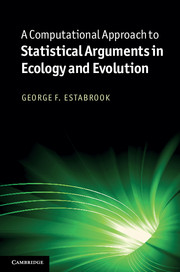Book contents
- Frontmatter
- Contents
- Acknowledgments
- 1 Introduction
- 2 Programming and statistical concepts
- 3 Choosing a test statistic
- 4 Random variables and distributions
- 5 More programming and statistical concepts
- 6 Parametric distributions
- 7 Linear model
- 8 Fitting distributions
- 9 Dependencies
- 10 How to get away with peeking at data
- 11 Contingency
- References
- Index
1 - Introduction
Published online by Cambridge University Press: 05 June 2012
- Frontmatter
- Contents
- Acknowledgments
- 1 Introduction
- 2 Programming and statistical concepts
- 3 Choosing a test statistic
- 4 Random variables and distributions
- 5 More programming and statistical concepts
- 6 Parametric distributions
- 7 Linear model
- 8 Fitting distributions
- 9 Dependencies
- 10 How to get away with peeking at data
- 11 Contingency
- References
- Index
Summary
Purpose
The purpose of this book is to teach you how to make statistical arguments using computational approaches. Such arguments are based on test-statistic probability distributions predicted by hypotheses, as in the classical approach. Unlike the classical approach, these predicted probability distributions are calculated by direct simulation of the hypotheses themselves. This approach enables you to use anything that can be calculated (or observed) from your data as a test statistic, and hypothesize any probabilistic mechanism that can generate data sets similar in structure to the one you observed. This approach frees you from the constraints, mysterious formulas, and sophisticated mathematics that classical statistics entails, and enables you to take personal control of your statistical arguments. To access this power, you will need to learn to program a computer (if you do not already know how). This task is greatly simplified through the use of spreadsheet macros, which enable the organization and input of data, as well as the output of results, using the spreadsheet itself. Many of you are already familiar with spreadsheets. The macros you will need to program will serve mostly to perform calculations, so that you will need to learn only a small sub-set of the programming language. In this book, I discuss basic hypothesis-testing statistical argument, data structures, choice of test statistics, some probability theory and its use in formulating hypotheses, and enough programming techniques to specify the calculations that simulate data sets using probabilistic hypotheses. Much of the discourse is with natural examples. Although this computational approach to statistical argument is widely applicable, these examples are mostly drawn from anthropology, ecology, evolution, and paleontology, which are my areas of interest, and those of most of my students.
Intended readers
This book is intended for readers who aspire to become, are already becoming, or who have become, research scientists who would like to feel more in control of their statistical arguments. It does not expect you to have prior training in statistics or computer programming, but some of my students who have had such training found this book valuable because it provided a very different view of these subjects, especially of statistics. Earlier versions of this book have existed in unpublished form for the past decade. I used them to teach my course on computational approaches to statistical argument at the University of Michigan. My students have been mostly Ph.D. students (about half in biological anthropology, and the others in paleontology, ecology, and evolution, with a few other areas occasionally represented). However, a few masters students, undergraduates planning to attend graduate school, post-doctoral fellows, and even fellow faculty have also participated.
- Type
- Chapter
- Information
- Publisher: Cambridge University PressPrint publication year: 2011

